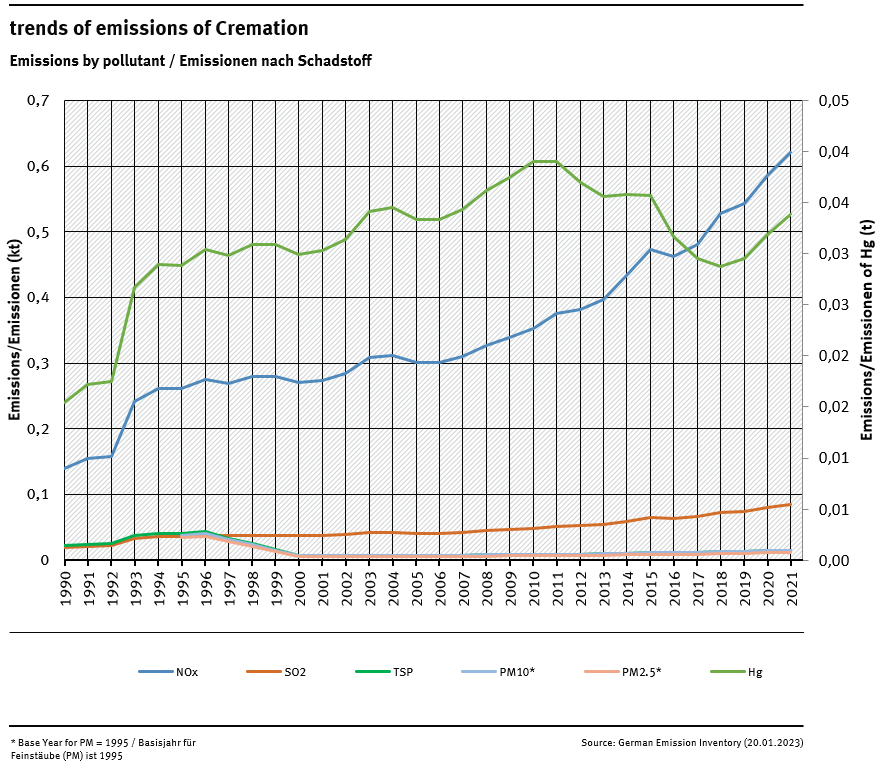meta data for this page
5.C.1.b v - Cremation
| Category Code | Method | AD | EF | ||||||||||||
|---|---|---|---|---|---|---|---|---|---|---|---|---|---|---|---|
| 5.C.1.b.v | CS | AS | D, CS | ||||||||||||
| NOx | NMVOC | SO2 | NH3 | PM2.5 | PM10 | TSP | BC | CO | Pb | Cd | Hg | Diox | PAH | HCB | |
| Key Category: | -/- | -/- | -/- | - | -/- | -/- | -/- | - | -/- | -/- | -/- | -/- | -/- | -/- | -/- |
Method
Emissions from cremation are not a key source and of minor priority. Since March 1997, a national legal ordinance for cremation plants nationwide is in force (27. BImSchV).
Activity data
Activity data for this category are based on data from the statistics of the “Bundesverband Deutscher Bestatter e.V.”1). For purposes of GHG reporting we specify cremations as masses, too. The cremation is a growing trend in funerals.
Table 1: Annual amount of cremated human bodies, in [kt]
| 1990 | 1995 | 2000 | 2005 | 2010 | 2015 | 2020 | 2021 |
|---|---|---|---|---|---|---|---|
| 13.55 | 25.32 | 26.24 | 29.22 | 34.18 | 45.88 | 56.77 | 60.19 |
Source: own calculation, conversion is not described in more detail here for reasons of piety, but is done in a manner comparable to other publications.
Emission factors
Emission factors used are default values from the EMEP/EEA air pollutant emission inventory guidebook 2016 2) as well as new national data for POPs from the research project “POP- und Hg-Emissionen aus abfallwirtschaftlichen Anlagen” - Teilvorhaben zum Globalvorhaben „Überprüfung des Standes der Technik der Emissionen prioritärer Schadstoffe für einzelne Industriebranchen (Kleinfeuerungsanlagen und abfallwirtschaftliche Anlagen)“ 3) .
In 2018 the TERT noted that the German Hg EF is 100 times smaller than the default value proposed in the 2016 EMEP/EEA Guidebook and the Cd and Pb EF are 1000 times smaller than the default values proposed in the 2016 EMEP/EEA Guidebook. However, the EF for Pb and Cd are based on national expert judgement: assumption that a) the emissions behave similarly to dust and b) the dust limit value of the air pollution control specification (27th BImSchV) is complied with (to be confirmed on the basis of the new measurement data from 5 crematoria with different exhaust gas cleaning systems). The Hg EF was calculated on the basis of the German report on “OSPAR Recommendation 2003/4 on controlling the dispersal of mercury from crematoria“, but is under evaluation.
After the finalization of a research Project 4) the Hg EF is revised. As part of the project, emission measurements were carried out at six cremation routes. According to OSPAR reporting 2010/2014, approx. 90% of the plants have effective Hg mitigation technology, whereas approx. 10% are not equipped with effective Hg mitigation technology. This ratio is roughly reflected in the 2020 project report, too. This results in the following weighted mean value:
0.9 x 0.0225 g/h + 0.1 x 0.2468 g/h = 0.0449588207 g/h.
Since the cremation duration is approximately one hour, the mean value per hour corresponds to the Hg load per cremation and is used accordingly in the inventory calculation. Values are interpolated between the two endpoints 2010 and 2018.
EF for TSP, PM10, and PM2.5 derive from the research study “Studie zur Korngrößenverteilung (PM10 und PM2.5) von Staubemissionen” 5).
Trends in emissions
Most emission trends are the result of the increasing trend of AD, partly with decreasing EF at the same time. As result even the trend for Hg emissions is decreasing for a temporary period.
Recalculations
With activity data and emission factors remaining unrevised, no recalculations were carried out compared to Submission 2022.


